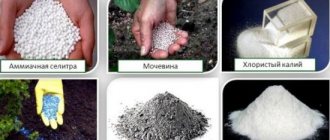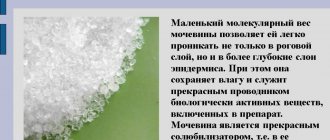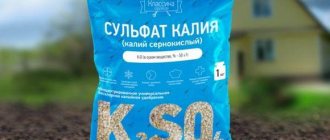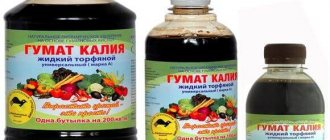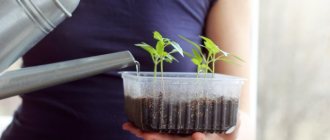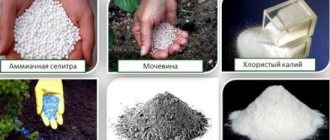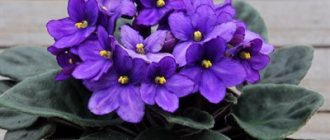22675
Every gardener has heard about the need for fertilizers to grow tasty crops and prevent diseases of garden crops. Beginners will have to understand the types of fertilizing and the timing of their application. Nitrogen and potassium fertilizers are most often used; there are many names. Beginning summer residents have to figure out which of them to use in the spring and during fruiting in order to provide timely assistance to garden crops and positively affect the quality of the harvest.
Fertilizing strawberries with potassium solution
Why do we need potash fertilizers?
Potassium is considered the most important element that affects the life of plants. It can be found in the cytoplasm and cell fluid (sap), and phosphorus and nitrogen are considered components of organic compounds. Potassium in the soil layer restores water balance and also has a positive effect on metabolism.
When feeding potassium-deficient vegetation with nitrogen fertilizers, unprocessed ammonia is formed, which negatively affects the life activity of these living organisms. The same thing happens with a lack of carbon.
Potassium deficiency in the soil layer prevents monosaccharides from becoming polysaccharides. Therefore, it is used to store starch. Due to the huge sugar content in the cells, vegetation becomes more resistant to frost. Substances that affect the aroma are also formed with the participation of a substance called Kalium.
Plants need potassium for a reason; it protects against diseases such as rust and powdery mildew. Potassium makes the stems harder and stops the early ripening of fruits. This is important, because such fruits have an excess of phosphoric acid in their composition.
Potassium also helps the root system develop, speeds up metabolism and extends the shelf life of products. It is especially needed during the growing season and at the stage of fruit formation. Potassium fertilizers give plants the opportunity to develop. In order for potassium to be more beneficial, it is used together with nitrogen and phosphorus fertilizers.
How do you get it?
The manufacturing technology of potash fertilizers depends on the composition and purpose of the preparations:
- Potassium chloride is obtained by flotation. For this purpose, mineral formations are used. In this case, the sylvinite is ground, after which it is treated with a mother solution. During the production process, the liquor is separated from the sediment. As a result, it is possible to obtain potassium chloride in crystalline form.
- Potassium sulfate is obtained by mixing schenite and langbenite.
- To obtain potassium magnesium, you need to process chenite. The substance comes to the market in the form of granules or gray-brown powder.
- Potassium salt is a mixture of potassium chloride and sylvinite. Sometimes the second component is changed to kainite.
See also
How to make mulch with your own hands, preparation from 8 types of componentsRead
Types of mineral potassium supplements
There are many different potash fertilizers; information about each type will be provided below.
Potassium chloride (KCl) mixed with NaCl
This fertilizer visually resembles pink powder and can contain up to 60% potassium. The fertilizer contains chlorine. This fertilizer is considered the most effective, according to gardeners. Approximate dosage: 20 grams per 1 meter. Potassium chloride should not be used to fertilize vegetables and berries.
Potassium sulfate (K2SO4)
Fertilizer without chlorine, perfect for all vegetables. The supplement contains 50% potassium. The fertilizer looks like yellow powder. Due to the content of sulfur, magnesium and calcium, the additive can be used for beans and cabbage.
Wood ash (K3PO4, K2CO3)
This fertilizer is considered natural, it is inexpensive and anyone can buy it. This fertilizer contains 11% potassium. Wood ash should not be mixed with manure and other nitrogen-containing additives. You can add K3PO4, K2CO3 to the soil layer at any time, even in winter (in greenhouse conditions). One liter jar is enough for 1 m2. Wood ash is sold without chlorine. This composition has a positive effect on root vegetables. In addition to potassium, the fertilizer contains a lot of calcium, which reduces the acidity level of the soil layer.
Potassium salt (KCl*MgSO4*3H2O) with an admixture of NaCl
This chlorine supplement contains 40% potassium. It can only be used to fertilize sandy soils. Experts are sure that spring and summer are not the best time to apply fertilizer. It is better to apply it in the fall, feeding fruiting woody plants and berries. Even if chlorine does not harm the crop, you need to be careful and follow the dosage.
Potassium carbonate (K2CO3)
This fertilizer is also called "potash". Typically, potassium carbonate is used on potatoes. The fertilizer contains approximately 50% potassium, and a small amount of sulfur and magnesium. When to add this additive to the soil layer? At any time, but not in winter, given that the plant can absorb the maximum dose only in the spring (up to 100 grams per 1 sq. m).
Potassium nitrate (KNO3)
This additive is used to fertilize fruit-bearing crops. Nitrate is perfectly absorbed by vegetables from the greenhouse. If you are deficient in potassium, your plants will grow slower.
Saltpeter, filled with potassium, but without chlorine. When using this additive with other fertilizers, be sure to break everything up with water.
Potassium humate (C5H8KNO4)
This fertilizer is based on humic salts. It is often used by gardeners when growing grain crops. The active component, together with organic acids, has a positive effect on root growth. Potassium humate increases the cold resistance of crops, ensures flowering, and has a positive effect on fruit ripening.
Fertilizers from industrial waste
Many gardeners use old and unnecessary products/preparations to fertilize their gardens, which have been lying idle at home for a long time. Let's look at the most popular fertilizers that can be found in your home.
Cement dust (K2CO3, KHCO, K2SO4, CaCO3, MgO, etc.)
It contains no chlorine and is used for vegetation that does not tolerate chlorides well. Due to some features, cement dust perfectly combats the high acidity of soil layers. Sometimes the substance is used together with scarlet kainite, a mineral that contains potassium chloride and magnesium. To form a good harvest, it is better to cultivate the soil layer in the fall.
Common mistakes in using superphosphate to fertilize plants
Cement dust is used to add to podzolic soil. The supplement contains approximately 30% potassium, which is perfectly absorbed by plants. Sulfates, silicates, bicarbonates affect the solubility of the fertilizer, accelerating the process.
Furnace ash
Furnace ash is safe because it contains no chlorine and neutralizes acidity. Usually it is bought for garden crops. Furnace ash also contains 14% potassium and 7% phosphorus. Many consider this fertilizer to be a complex product due to the phosphorus in its composition.
Complex fertilizers
New trends in the creation of potassium-based fertilizers involve an increase in the number of complex products. The difference between complex nutrition and a regular additive is that it can consist of two or three components.
Kalimag (K2SO4*MgSO4)
This fertilizer can be called potassium magnesium, which contains a small amount of calcium, potassium, chlorine, sulfur and magnesium. The proportion of potassium in the composition is up to 20%. Kalimag can be used for various types of vegetation.
Multipotassium (N-P2O5-K2O)
The fertilizer contains nitrogen and potassium. Suitable only for vegetables and flowers. The second name for multipotassium is “potassium nitrate.” Ballast-free components ensure rapid digestibility of crop nutrition and good solubility. Multipotassium does not contain chlorine. Sold in the form of a snow-white powder.
Calimagnesia (K2SO4*MgSO4)
Calimagnesia contains chlorine (3%), but experts do not consider it harmful due to its minimal concentration. This pink powder, called potassium magnesium, absorbs virtually no moisture. Therefore, it is used to care for indoor plants.
Nitrophoska
Nitrifoska is an additive with a triple effect (because it contains nitrogen, potassium and phosphorus). In percentage terms, all substances are present in equal quantities. This fertilizer is used to support garden plants. Nitrophoska is formed by the sulfur-nitrate method. The fertilizer is classified as chlorine-containing.
Nitroammophoska (NH4H2PO4+NH4NO3+KCL)
The fertilizer called nitroammofska contains three important substances. Nitrogen, potassium and phosphorus (16% each). These components have a positive effect on tomatoes, which is why the additive is used to grow them.
Application
When feeding vegetation in a greenhouse or garden, it is important to take into account not only the characteristics of the plant, but also the type of soil layer. For example, in heavy soils with low permeability of substances, it is necessary to apply complex fertilizers in the autumn. In the case of light soils, mineral fertilizers can be applied in the spring to prevent their accidental leaching.
General rules
So, before use, it is worth studying the general rules for laying potash fertilizers: the period for processing the light soil layer is spring, and for the heavy version, autumn is suitable. Autumn dosage is 15-20 g/m2, spring dosage is 2-3.5 g/m2. It is worth taking the advice of experienced gardeners and checking the composition of the soil in the laboratory, then you will know exactly what fertilizing to apply.
Complex supplements can consist of various beneficial substances, stimulants and microelements. They are sold in solid and liquid states, and can be used as root and foliar feeding. Liquid solutions need to be purchased for root watering. They are used during the growing season, after a rainstorm.
This helps protect the roots of vegetation by reducing the concentration of substances. It is important to avoid getting the solution on the leaves - they may “burn.” Granular complex fertilizers are used when digging or loosening the soil layer. In spring, sprinkle fertilizer in a certain concentration (depending on the crop) directly on top of the snowdrifts. The rest of the time, feed the plants during dry periods when there is no bright sun.
How to choose the right one
When choosing a fertilizer, you must consider the following points:
- What kind of soil layer is there in the area, its acidity. It depends on how much she needs this microelement. It is better to buy a fertilizer that contains almost everything so as not to suffer.
- Which plants should be fed? Not all crops benefit from minerals.
- Compound. You need to look at the packaging and check whether the supplement contains: nitrogen, phosphorus and potassium. If there is, look at the percentage, you may come across the following option: 17x17x17. If you add these percentages together, you get the figure 51, which means part of the fertilizer is filled with unnecessary salts that will not bring any benefit. When is the best time to use fertilizers? A season is selected for each plant, as crops perceive climatic conditions differently.
If you keep the above points in mind, you can avoid serious problems with your plants in the future.
in autumn
Fertilizing in the fall will allow elements/minerals to be absorbed into the soil along with moisture. This will ensure a good harvest next season. The list of fall additions includes:
- humus;
- fertilizers with phosphorus;
- compositions filled with potassium.
When choosing fertilizers, do not forget to take into account the individual characteristics of trees, plants and bushes.
in spring
In the spring, abundant feeding will be required. A properly applied complex product for fruit trees will bring a large harvest. It is recommended to use liquid and granular fertilizers at this time of year.
How to use?
For the use of potash to be effective, you need to take into account the type of crops grown:
- Cucumbers. To produce 100 kilograms of fruit, 440 grams of potassium are required. It is recommended to use double salt, which contains a minimum of chlorine.
- Potato. This culture perfectly assimilates Kalimag. You should add 1 small spoon of the product into each hole.
- Tomatoes. To produce 100 kilograms of tomatoes, 500 grams of potash are required. Since this crop needs phosphorus, it is better to use complex substances. The use of potassium magnesia increases productivity by 40%.
- Strawberry. This crop does not tolerate exposure to chlorine. Therefore, fertilizers containing this component must be applied in the fall with lime. Potassium makes fruits sweeter and increases their shelf life.
Application of potash fertilizers
The rules for using the additive depend on its content, as well as the type of plants grown. Knowing which products contain potassium, you can double your yield. It is better to add potassium additives to the soil (especially if they contain chlorine) before digging, which means you should have time to do everything before the fall. Potash fertilizers delight all gardeners with the following properties:
- increasing the resistance of vegetation immunity;
- pest protection;
- compatibility with other useful fertilizers;
- stimulating the development of cultures.
Almost all varieties of plants perfectly absorb complex potassium supplements due to the conversion of mineral salts into ionic form. But the most important condition for the use of fertilizing is compliance with the dosage.
Banana peel as a fertilizer for garden flowers: how to use so as not to harm
There are instructions on the packaging of any product that should be read before use, but there are also standard rules for using fertilizers that should be taken into account:
- different additives are used at different time periods. Some are applied before planting, others during vegetation growth;
- fertilizer can be used only if it is fresh. If the expiration date has passed, get rid of the fertilizer;
- To preserve the goods, you need to immerse them in airtight packaging. Stale fertilizer should be kneaded and made free-flowing for subsequent use;
- Be sure to remember the dosage that is on the packaging material;
- When feeding, do not allow the mixture to get on the leaves and stems of vegetation. If you have already made a mistake, you need to wash the mixture off the plant with water;
- Bulk fertilizers should be applied shallowly into the soil, so they will be accessible to the roots.
Before purchasing potash fertilizers, you must consider all of the above recommendations to avoid mistakes.
Basic feeding when digging or plowing land in the fall
How the main fertilizing is carried out, a brief description of the process: the procedure is carried out in the fall, before the main cultivation of the soil layer, fertilizers are scattered with powerful heavy special equipment (if the area is small, standard improvised means may also be suitable) with laying in the soil to the depth of the arable layer (ploughs, cutters, or heavy disks).
At this stage, organic fertilizers are laid, and from mineral fertilizers - phosphorus and potassium mixtures. Phosphorus and potassium are very inactive in the ground, and it is better to immerse them deeper, where the base of the root system will develop. In addition, mixing with soil will help avoid high salt concentrations near the seedlings. In this case, nitrogen fertilizers are not applied, since nitrogen is quickly washed out of the ground.
Pre-sowing fertilizing in spring
After the main fertilizing, the next step will be pre-sowing application. It is performed in the spring, before sowing the crop (for winter crops, the best option is early autumn or late summer). The incorporation of the product is carried out by pre-sowing cultivation or harrowing, shallowly, which determines the choice of additive - in most cases, nitrogen species are used (ammonium nitrate, urea, UAN, sometimes sodium or calcium nitrate). The pre-sowing layer (like the main one) is considered continuous; the product is scattered evenly over the entire ground.
Additional feeding
Well, at the end, additional fertilizing is carried out, which is also called pre-sowing. Fertilizers are applied only to certain areas. The preparations are applied according to the seed sowing lines and placed a few cm deeper than the sowing depth.
That is why phosphorus fertilizers are most often used for additional feeding. Even on soil layers with excellent levels of phosphorus, similar products are also used, but in small quantities - from 5 to 10 kg. d.v/ha.
You can also use complex formulations; the presence of potassium, calcium, and microelements in such a fertilizer will definitely be beneficial, but you need to be very careful with the doses.
Top dressing
It is important to use soil fertilizers in accordance with their intended purpose. Below we will tell you which complex formulations are suitable for plants, flowers, shrubs and trees.
For fruit trees
Complex additives for trees are applied in spring or autumn. The ideal time to work starts at the end of August and ends in September. Compliance with the deadline allows you to fill the trees with energy for growth. Most often, liquid fertilizers are used, which are quickly absorbed by the roots, as well as dry compounds that penetrate the soil during watering. Popular tree feeding options: potassium magnesia and ash.
For flowers
Flowers need very nutritious feeding, because the lack of nutrients affects the color scheme and general condition.
The following fertilizers are suitable for flowers:
- organic species;
- mineral supplements;
- liquid products;
- foliar.
The choice of fertilizing is a responsible matter; remember that each species requires a certain type of fertilizer. Most often, when caring for flowers, the following nutritional additives are used: ammophos, nitrophoska and nitrophos.
For strawberries
Diammophos can provide strawberries with protection from insects and rapid growth; it is filled with calcium, potassium, nitrogen, magnesium, phosphorus and sulfur. Gardeners also sometimes add nitroammophos and ammophos. Strawberries need to be fertilized from April to August.
For onions and garlic
These plants love soil filled with useful and nutritious elements. To obtain a rich harvest, fertilizing the soil throughout the entire period is required. Excellent results will be achieved by adding organic matter, as well as using superphosphate or nitroammophosphate.
For cucumbers
Fertilizers applied in the fall accelerate the development of seedlings, fruiting and improve yields. Also, complex compositions save cucumbers from insects and diseases.
Fertilizer application schemes are different:
- when planting seeds, you can use products based on nitrogen, phosphorus and potassium;
- to feed seedlings, you should take ammonium nitrate or mullein;
- When transferring seedlings to open ground, it is worth using superphosphate, as well as potassium chloride.
- To improve fruiting, add magnesium and nitrogen supplements.
When feeding cucumbers, please do not forget to take into account the dosage.
For potatoes
A complex vegetable fertilizer or a targeted additive (for example, Fusco) will help save potato bushes from insects and increase the volume of tubers at the beginning of summer. It can definitely increase yields and speed up the ripening process. An excellent result will be provided by a mixture of humus with ash and nitrophos, as well as saltpeter filled with potassium and nitrophos.
For tomatoes
Saturation of the soil layer with useful elements increases fertility and yield. The products used include potassium monophosphate and calcium nitrate. These fertilizers are diluted in liquid or spread over the soil. Tomatoes will have to be fertilized throughout the entire growing period.
Tinder fungus with benefits for the garden: where and how to use it
For lawns
It is necessary to fertilize the lawn immediately after mowing. Each type of lawn should receive individual care:
- for sports lawns it is worth using Aquarin Lawn;
- universal coating deserves feeding called Flovorit;
- Fertika fertilizer is suitable for all types.
The range of fertilizers is quite large and wide, so try to choose the best fertilizer.
Houseplants
If your houseplant has too little potassium in its soil, it will not bloom properly. To feed indoor plants that need slightly acidic and acidic soil, it is worth buying potassium sulfate. Large house perennials that cannot tolerate chlorine will need to be fertilized with potassium magnesium. The feeding period depends on the type of plant.
Furnace ash
Potash fertilizers include stove ash. But not all plants love this natural fertilizer. Ash is not suitable for growing turnips and radishes; flowers like camellias and azaleas do not like it. Ash cannot be used on clay soils and saline soils.
On other soils, ash will be beneficial, so it must be applied at least once a year to all types of plants.
DIY potassium monophosphate
Potassium fertilizer from ash can be made at home. To do this, pour a glass of ash into a bucket of water and let it brew for 2-3 hours, then water the plants.
Potassium, as a fertilizer, is found in potassium monophosphate, which Ivan Russkikh recommends making with your own hands.
Ivan Anatolyevich Russkikh
Popular video blogger, expert of the Procvetok Youtube channel and the Ivanova Science channel. Researcher, teacher, head of the Research Laboratory of the Russian Center for Economics and Culture, member of international scientific communities.
How can I replace store-bought fertilizers with phosphorus and potassium? Prepare monophosphate yourself:
- You need to pour 0.5 liters of ash into 1 liter of water; for ease of preparation, pour it into a 3-liter jar.
- Gradually pour orthophosphoric acid into the jar until bubbles stop appearing in the jar with ash. Phosphoric acid is found in Coca-Cola, toilet cleaners and anti-corrosion products.
- Then pour 1 cup of monophosphate into 1 bucket of water and water the plants.
You can increase the yield by adding monophosphate to moist soil, that is, after watering:
- Apply under annual plants in spring.
- For perennial plants - throughout the season
DIY potash fertilizer
At home, you can quickly prepare valuable potassium fertilizer from dried banana peels. In addition to potassium, it will also contain nitrogen.
Dry banana peels can be ground and sprinkled under each plant, and then embedded in the soil. Or you can prepare an infusion: put the peels of two bananas in a jar, add water, and after a day you can water your indoor flowers.
Advantages and disadvantages
All the pros and cons of potash fertilizers will be listed below:
- They are popular because they are very healthy, because they contain a lot of potassium, and some varieties even lack chlorides.
- The types of potassium fertilizers are varied. They can be divided according to the degree of impact, production and method of application. Potassium salts are used as raw materials for creating potash fertilizers.
- They have a positive effect on the processes of plant growth and development.
- They have a minimal percentage of unnecessary components.
- long period of exposure - usually 2 feedings per season are enough;
- easy to mix and dissolve.
- They allow you to reduce the area of watering and enable plants to adapt to aggressive conditions.
- Versatility - used even when growing plants that are especially sensitive to environmental changes.
- Easy to apply, store and safe.
There are also disadvantages. The main problem when buying this fertilizer is not the price, but the scarcity of choice. The compositions are almost the same. There are very few comprehensive tools, especially on the Internet. Therefore, for crops that require an individual approach, you will need to purchase additional nutrition that meets their needs.
Potash fertilizers are harmful to humans
Potassium fertilizers, when dosed correctly, will not harm anyone. Only their excessive application can lead to the death of vegetation, a decrease in the quality of the crop and poisoning. You should use additives with chlorine with caution - they need to be added in the fall so that the chlorine immediately evaporates from the soil layer, and potassium becomes more firmly entrenched in it.
Of all mineral fertilizers, nitrogen fertilizers pose a real danger to people. This is potassium, calcium, ammonium nitrate. In case of overdose, they turn into nitrates and, penetrating into the human body, can cause asthma attacks, cancer, nausea and dizziness. When treating vegetation with products containing nitrogen, the dosage must be strictly observed.
Negative consequences of applying potassium fertilizers for soil, microorganisms and plants
Fertilizers, especially if used incorrectly, can be a factor in environmental disaster, and not only where they are used. Their negative impact can spread further.
Fertilizer residues penetrate into groundwater, filling them with nitrates. Open reservoirs, after the ingress of nutrients from fertilizing, are subject to esterification, which leads to the rapid development of vegetation in reservoirs. This is mainly facilitated by the presence of nitrogen and phosphorus. When the ratio of these biological genes is 2:1, blue-green algae develop because of this.
If the remains of nitrogen fertilizers - nitrates - can accumulate in crop products, then if the rules for laying nitrogen fertilizers are not followed, mass poisoning of people and some animals will begin (there are known cases of people being poisoned by watermelons and melons).
Mineral fertilizers can also cause harm; they can not only increase, but also reduce soil fertility. This happens when too little organic fertilizer is added to the soil layer.
Additives can even harm wild animals: the capture of fertilizer granules by birds, as well as the licking of old fertilizers by animals (elks, pigs, roe deer), causes poisoning. The introduction of high doses leads to a reduction in the soil layer of earthworms - the most important objects of soil biocenosis.
Storage
The main condition for storing mineral supplements is a well-ventilated room, dry and preferably separate from other rooms or buildings. When storing such fertilizers, it is unacceptable to wet them with water. Because of this, they may lose their beneficial properties.
All types of nitrate (ammonium, potassium, calcium) must be stored with extreme caution, as it is explosive and can detonate from physical impact. The most dangerous type is potassium nitrate. It is unacceptable for fabric or cellulose elements to penetrate ammonium or potassium nitrate, as they will also become explosive over time.
The process of storing fertilizers must be handled responsibly. They should be kept separately from each other (on shelves), in their original packaging, and tightly covered. Also, when storing fertilizers, do not allow mixing. With such interaction with each other, they can form toxic or useless substances.
The shelf life of mineral supplements is on the packaging, and depending on the manufacturer, similar products are given a shelf life of 1 to 3 years. You should not use stale products, they will not bring any benefit. The shelf life of organic additives in raw form is 9 months. However, dry and packaged manure, compost or peat can last for many years and retain its properties. The factory packaging of organic preparations has holes for ventilation.
Potassium fertilizers can be used to grow any vegetation, since not only the frost resistance of the plant, but also its tolerance to drought and lodging depends on the amount of nutrients in the soil. Potassium supplements also help increase the size of the future harvest and protect it from diseases.
Signs of potassium deficiency in plants
In plants suffering from a lack of potassium, ammonia accumulates in the cells. They become susceptible to fungal infection. Often, shoots die off in such vegetation.
Plantings on light soil are susceptible to mineral deficiency. Its symptoms appear in the summer at the stage of active growth.
Potassium deficiency in plants can be determined by the following signs:
- development of brown spot;
- yellowing of the foliage, over time its color becomes brown (there may be a bluish tint with a bronze sheen);
- the appearance of a marginal burn on the leaves;
- the veins on the leaf plate become invisible;
- stems become thinner;
- slowdown in crop growth;
- leaves wrinkle and curl;
- budding begins later than expected.
